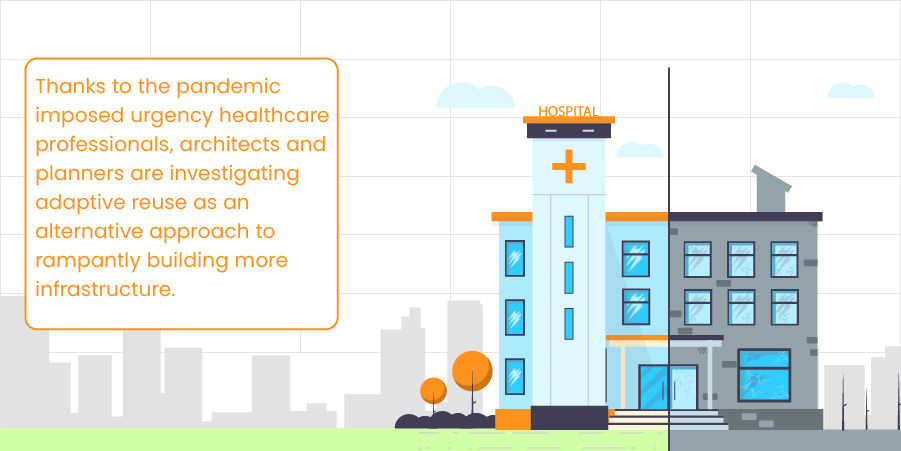01-04-2022
Can old, depleted buildings solve India’s healthcare crisis? Ravideep Singh

The Covid-19 pandemic questioned healthcare systems across the world. India’s already deficient healthcare infrastructure grappled with the three waves and is now preparing for any future crises. Healthcare planners are currently exploring various strategies that can enable setting up and expanding healthcare facilities — rapidly and economically.
Furthermore, over the past few decades, we have witnessed the emergence of new buildings and technology that has accelerated urbanisation. As a result, disused buildings and abandoned construction sites are becoming increasingly common. With green building codes and energy-efficient guidelines making their way into building designs, we are beginning to see the dis-composing irony of building sustainable infrastructure.
As a result, adaptive reuse of older, depleted, or otherwise vacant buildings is gaining momentum. Lately, the phenomenon of adaptively repurposing and reusing existing built structures has been a successful endeavour for several industrial and commercial projects. Moreover, the efficacy of ‘adaptive reuse’ especially in healthcare, even though sceptic initially, is gradually gaining meaningful acceptance.
Today, healthcare systems are grappling with decreasing reimbursements and increasing costs. Thanks to the pandemic-imposed urgency to swiftly ramp up, expand and set up new health infrastructure in the race to outrun the viral mutations, healthcare professionals, architects and planners are investigating adaptive reuse as an alternative approach to rampantly building more infrastructure. The notion of adaptive reuse strategy’s sizable reduction in cost and time observed in the other building types might not transpire as such in healthcare facilities by certain peculiarities that healthcare environments necessitate. However, this approach offers financial, environmental, and communal benefits with careful consideration and meticulous planning.
One of the principal factors of a healthcare building’s feasibility is its location, visibility, and accessibility. Hospital buildings often require loftier floor-to-floor heights than other typologies to accommodate the complex mechanical and service systems. Low structural floor heights in older buildings can pose a challenge to its repurposing and lead to increased costs. Accounting for the constantly evolving technology and medical equipment, architects must also consider the potential of MEP induction in the existing structure.
Furthermore, it is crucial to examine the prospects of growth, flexibility and reconfiguration in a repurposed building to allow for a surge in bed counts and accommodate additional care units to serve a larger population. Along with a detailed analysis of the site conditions, structural integrity and other operational viability considerations, architects must ensure that the project complies with regional and national building codes. By investigating the various prospects of adapting an existing building to a hospital, generating a point-based decision matrix can help establish the project’s overall feasibility. In addition to the pragmatic factors, healthcare planners must re-design the building to ensure a safe and healing environment for patients, caregivers and healthcare workers. Architects must also factor in the prospects of improving community health and well-being and revitalising the structure for a holistic and sustainable approach towards the built environment.
At CDA, having undertaken several such brownfield healthcare projects, we consider the various factors at each stage of the design process, carefully evaluating and speculating on the outcomes of the project. While every project has unique challenges and opportunities, our goal remains to create a sustainable and healing environment. The design for the La Midas Wellness Centre in Gurgaon refurbished a twenty-year-old dwelling into a high-end wellness centre for women that stands tall as a bold piece of street furniture in a residential neighbourhood. Diyos Men’s Health Centre is another brownfield project that resurrected an old derelict residence. On a larger scale, CDA resuscitated 1.8 lakh sq ft of retail space into a full-fledged hospital in Kaushambi, Uttar Pradesh. The expansive atriums of the Shopprix Mall now serve as the entrance lobby of Yashoda Super Speciality Hospital. The Santosh Children’s Hospital is an ongoing project in Indirapuram, designed to transmute a dilapidated clinic into an engaging, responsive and altruistic built-form.
Our projects are a testimony to our commitment to transforming spaces that foster health and wellness. At CDA, we strive to deliver innovative, adaptive and sustainable healthcare solutions, with a goal to revolutionise the healthcare infrastructure — sustainably and altruistically. With meaningful interventions and a thoughtful design, adaptive reuse in the healthcare design realm is an opportunity to breathe new life into buildings, their inhabitants and the community.















